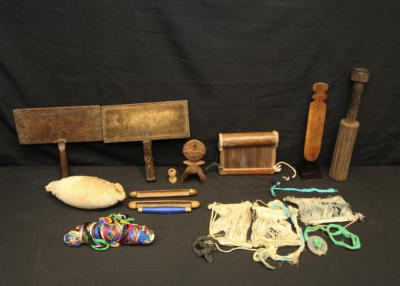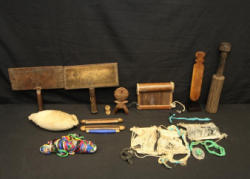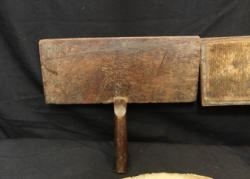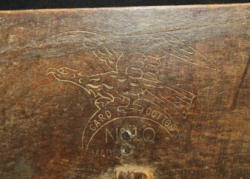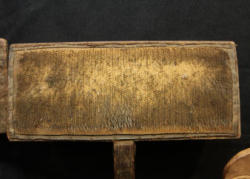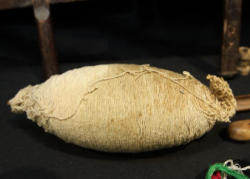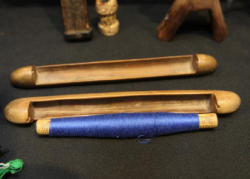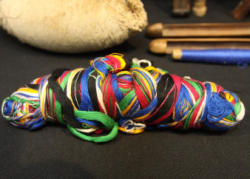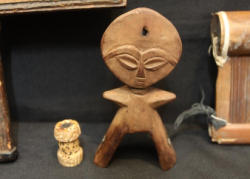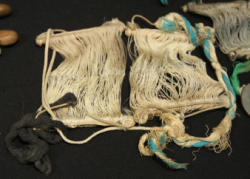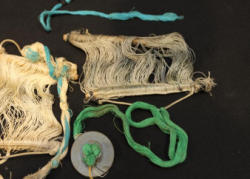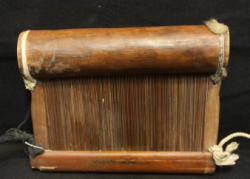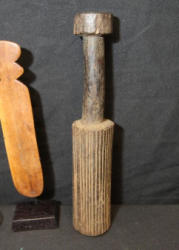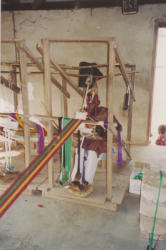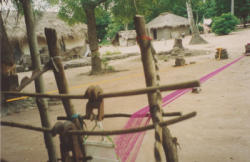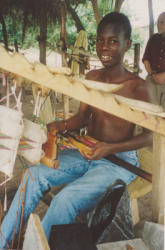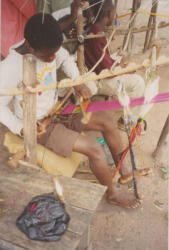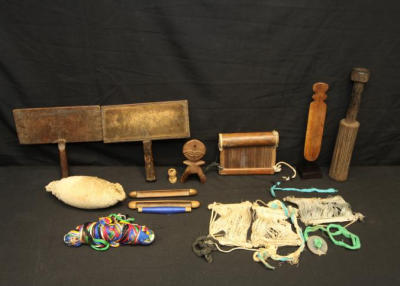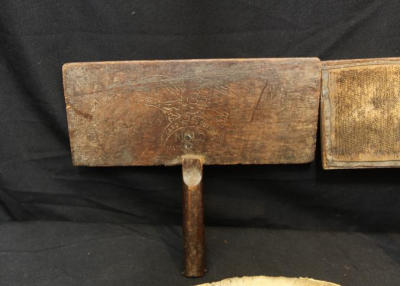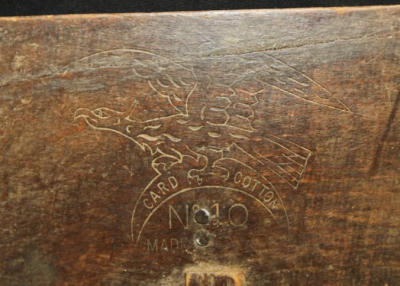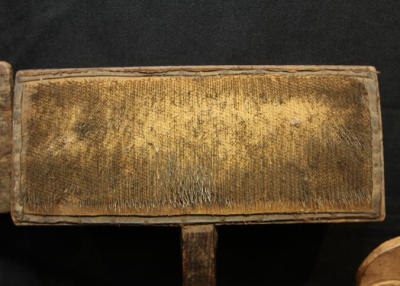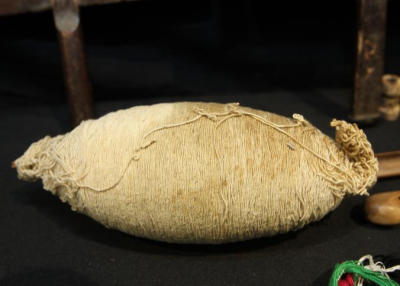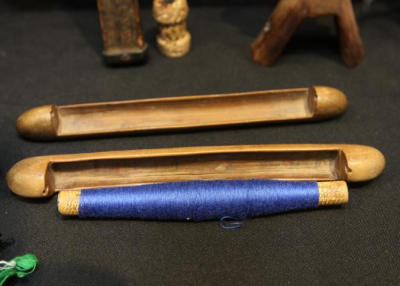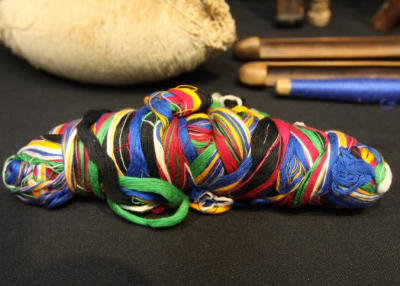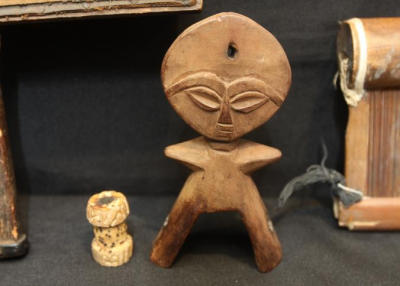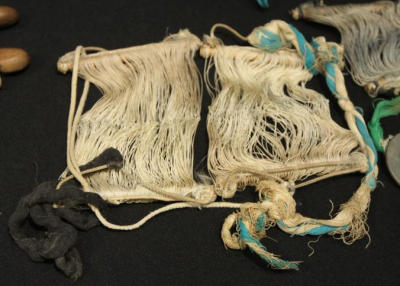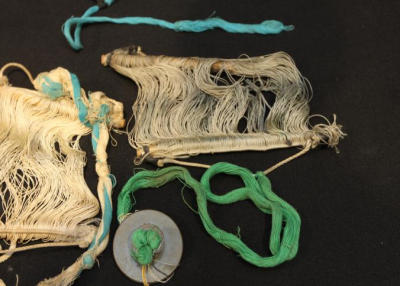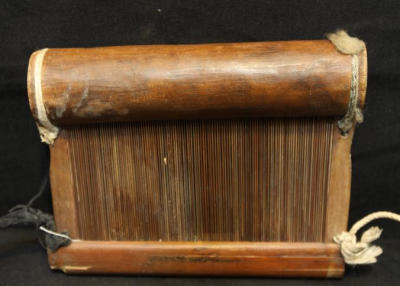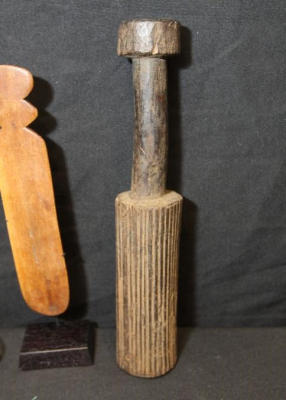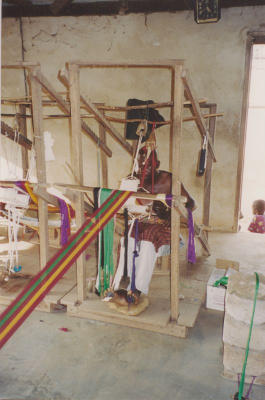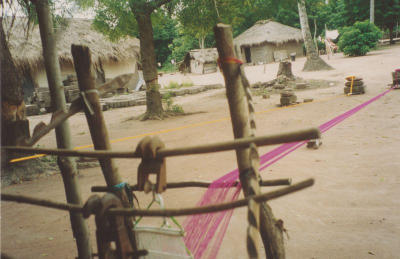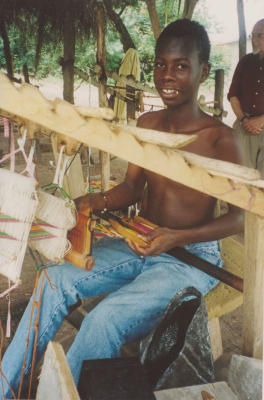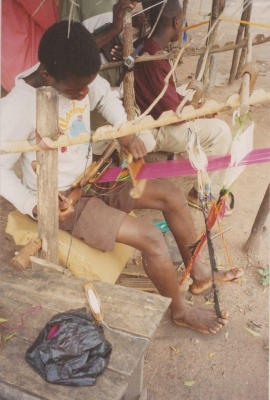Items located in Pleasant Valley, NY. Items include Tubular dance skirt & basket, Dida people, Ivory Coast. The skirts are worn by elderly persons, mostly widowed women, as a sign of prestige and wealth; Royal neck ring, Teke people, Democratic Republic of Congo. Heavy bronze neck rings such as this were worn by high status Chiefs with the title of Earth Lord; Face Mask, Ogoni people, Nigeria. This mask represents a British colonial officer wearing a pith helmet; Asafo military flag, Fante people, Ghana; Women's wraps, Burkina Faso. (A) Fulani people (?). Indigo dyed textile; Mami Wata crest mask, Temne people, Sierra Leone. Mami Wata is a siren or spirit associated with water and snakes; Copper Nineteenth century pre-coin currency objects, Congo and more.
AFRICAN ART COLLECTION OF MARY SUE AND PAUL PETER ROSEN Mary Sue and Paul Peter Rosen have collected African art for over thirty years, making nine trips to Africa to study the art in its cultural setting. The Rosens have published three African art books, curated more than ten exhibitions from their collection, and have given public lectures about African art and culture. They have donated art from their collection to various institutions including the Newark Museum, Temple University in Philadelphia, the SMA Fathers African Art Museum in Tenafly, New Jersey, and the African American Research Library in Fort Lauderdale, Florida.
Payment is due by Wednesday, March 28 at 1PM.
Pickup in Pleasant Valley, NY must be completed by Monday, April 2 at 3PM. We will be closed on Friday, March 30.
All lots sold as is, where is. There is a 15% Buyers Premium for all lots purchased. Payment methods include cash, MC, Visa, Discover or good check. You can make credit card payment online by going to your Member Area and selecting your invoice.
*NOTE* Shipping is available on all items.
J-B BACQUART: TRIBAL ARTS OF AFRICA 1998
ROSEN MS/ ROSEN PP: THE COLORFUL SOGO BO PUPPETS OF MALI 2012
J GILLOW: AFRICAN TEXTILES 2003
D CLARKE: THE ART OF AFRICAN TEXTILES 1997
AFRICAN ART COLLECTION OF MARY SUE AND PAUL PETER ROSEN Mary Sue and Paul Peter Rosen have collected African art for over thirty years, making nine trips to Africa to study the art in its cultural setting. The Rosens have published three African art books, curated more than ten exhibitions from their collection, and have given public lectures about African art and culture. They have donated art from their collection to various institutions including the Newark Museum, Temple University in Philadelphia, the SMA Fathers African Art Museum in Tenafly, New Jersey, and the African American Research Library in Fort Lauderdale, Florida.
Payment is due by Wednesday, March 28 at 1PM.
Pickup in Pleasant Valley, NY must be completed by Monday, April 2 at 3PM. We will be closed on Friday, March 30.
All lots sold as is, where is. There is a 15% Buyers Premium for all lots purchased. Payment methods include cash, MC, Visa, Discover or good check. You can make credit card payment online by going to your Member Area and selecting your invoice.
*NOTE* Shipping is available on all items.
THE FOLLOWING REFERENCES CITED BY AUTHOR(S) AND PUBLICATION YEAR IN VARIOUS LOTS ARE COMMERCIALLY AVAILABLE:
ROSEN MS/ ROSEN PP: MASKS FROM WEST AND CENTRAL AFRICA 2013J-B BACQUART: TRIBAL ARTS OF AFRICA 1998
ROSEN MS/ ROSEN PP: THE COLORFUL SOGO BO PUPPETS OF MALI 2012
J GILLOW: AFRICAN TEXTILES 2003
D CLARKE: THE ART OF AFRICAN TEXTILES 1997
Auction Info
Items located in Pleasant Valley, NY. Items include Tubular dance skirt & basket, Dida people, Ivory Coast. The skirts are worn by elderly persons, mostly widowed women, as a sign of prestige and wealth; Royal neck ring, Teke people, Democratic Republic of Congo. Heavy bronze neck rings such as this were worn by high status Chiefs with the title of Earth Lord; Face Mask, Ogoni people, Nigeria. This mask represents a British colonial officer wearing a pith helmet; Asafo military flag, Fante people, Ghana; Women's wraps, Burkina Faso. (A) Fulani people (?). Indigo dyed textile; Mami Wata crest mask, Temne people, Sierra Leone. Mami Wata is a siren or spirit associated with water and snakes; Copper Nineteenth century pre-coin currency objects, Congo and more.
AFRICAN ART COLLECTION OF MARY SUE AND PAUL PETER ROSEN Mary Sue and Paul Peter Rosen have collected African art for over thirty years, making nine trips to Africa to study the art in its cultural setting. The Rosens have published three African art books, curated more than ten exhibitions from their collection, and have given public lectures about African art and culture. They have donated art from their collection to various institutions including the Newark Museum, Temple University in Philadelphia, the SMA Fathers African Art Museum in Tenafly, New Jersey, and the African American Research Library in Fort Lauderdale, Florida.
Payment is due by Wednesday, March 28 at 1PM.
Pickup in Pleasant Valley, NY must be completed by Monday, April 2 at 3PM. We will be closed on Friday, March 30.
All lots sold as is, where is. There is a 15% Buyers Premium for all lots purchased. Payment methods include cash, MC, Visa, Discover or good check. You can make credit card payment online by going to your Member Area and selecting your invoice.
*NOTE* Shipping is available on all items.
J-B BACQUART: TRIBAL ARTS OF AFRICA 1998
ROSEN MS/ ROSEN PP: THE COLORFUL SOGO BO PUPPETS OF MALI 2012
J GILLOW: AFRICAN TEXTILES 2003
D CLARKE: THE ART OF AFRICAN TEXTILES 1997
AFRICAN ART COLLECTION OF MARY SUE AND PAUL PETER ROSEN Mary Sue and Paul Peter Rosen have collected African art for over thirty years, making nine trips to Africa to study the art in its cultural setting. The Rosens have published three African art books, curated more than ten exhibitions from their collection, and have given public lectures about African art and culture. They have donated art from their collection to various institutions including the Newark Museum, Temple University in Philadelphia, the SMA Fathers African Art Museum in Tenafly, New Jersey, and the African American Research Library in Fort Lauderdale, Florida.
Payment is due by Wednesday, March 28 at 1PM.
Pickup in Pleasant Valley, NY must be completed by Monday, April 2 at 3PM. We will be closed on Friday, March 30.
All lots sold as is, where is. There is a 15% Buyers Premium for all lots purchased. Payment methods include cash, MC, Visa, Discover or good check. You can make credit card payment online by going to your Member Area and selecting your invoice.
*NOTE* Shipping is available on all items.
THE FOLLOWING REFERENCES CITED BY AUTHOR(S) AND PUBLICATION YEAR IN VARIOUS LOTS ARE COMMERCIALLY AVAILABLE:
ROSEN MS/ ROSEN PP: MASKS FROM WEST AND CENTRAL AFRICA 2013J-B BACQUART: TRIBAL ARTS OF AFRICA 1998
ROSEN MS/ ROSEN PP: THE COLORFUL SOGO BO PUPPETS OF MALI 2012
J GILLOW: AFRICAN TEXTILES 2003
D CLARKE: THE ART OF AFRICAN TEXTILES 1997
Categories:
WEST AFRICAN STRIP WEAVING MATERIALS. (A) Pair of carding paddles used to transform raw cotton balls into strands that can be spun into threads. Late 19th-early 20th century. Labelled “CARD COTTON No1. Made by BFC FRANCE” with eagle trademark. Wire bristles, cloth, wood, nails. W 10.5in. (B) Oval bundle of hand spun cotton thread on a stick. Made by spinning cotton strands created with carding paddles. A bundle such as this was used to lay out the warp threads for undyed country cloth. A RARE FIND since commercially made thread wound on spools has been used for more than 75 years in West Africa. Mende people, Sierra Leone. Hand spun cotton thread, wood. L 10.5in. (C) Bundle of very fine, multicolored silk thread prepared to lay out the warp stripe pattern for an Ashante textile. Ashante people, Ghana. L 9.5in. (D) Two weaving “boats” (shuttles) and a hollow wooden spool with tightly wound fine blue thread. The spool rides on a wire that fits into a shuttle. Shuttle is passed back and forth between warp threads. Ashante people, Ghana. Wood, thread. “Boats” 8 in; Spool 6in. (E) Hand carved heddle pulley of Akan doll form and spool. Used to suspend a heddle through which warp threads are passed. Ashante people, Ghana.
Wood. Pulley H 6.0in; Spool H 1.5in. (F) Two Heddles. Used to separate warp threads. One or more warp threads are passed through each space between the “teeth” made of fine threads. (1) Ashante people, Ghana. VERY OLD single heddle made from numerous strands of fine thread suspended between two rods. A bundle of green threads tied to a rope loop on one side passes through the shaft of a disc (made by cutting a thread spool in half) that serves as a pedal which the weaver holds between two toes to raise and lower the heddle. Wood, thread. Heddle 6.5in. (2) Ashante people, Ghana. VERY OLD double heddle with same form as (1). The two heddles were operated in tandem in order to manipulate different sets of warp threads. The heddles were suspended by loops of rope at the top. The bundles of green and black thread on the bottom were used to suspend foot pedals operated by the left and right feet, respectively. Heddles 6in each. (G) Beater. Ashante people, Ghana. The beater was used to pull each weft thread tightly in place after it was passed between the warp threads. The ropes at each end were used to suspend the beater. Wood, rope. 5.5in x 7.5in. (H) Ashante people, Ghana. Weaving sword. Used to separate selected warp threads to pass weft threads in “boat”. On custom base. Wood. H 10in. (I) Grooved beater. Used to soften raffia cloth and to give sheen to waxed, tie-dyed cotton cloth. Face carved on handle. H 13in. SEE ATTACHED PICTURES OF WEAVERS AT WORK IN GHANA, the pictures are for reference only and are not included in the lot. {1. Weaver in his work station. Red, green and gold weft threads stretch from lower left into white heddle suspended from a heddle pulley. Weavers holds pedals to operate heddles between his toe. Bonwire Ghana. 2. View from inside a weaver’s work station showing weft threads attached to a weight to keep the taut as they enter heddles suspended from heddle pulleys. Sanga village, Ghana. 3. Apprentice weaver 18-year-old Stanley Emeybo holding a shuttle in his work station. Picture shows the position of two heddles and a beater on the warp threads. Sanga Village, Ghana. 4. An apprentice weaver holding a shuttle in his right hand is using a beater in his left hand to tighten a weft thread he has just inserted with the shuttle. Note his feet operating pedals attached to the heddles. Sanga Village, Ghana.}
More Details
WEST AFRICAN STRIP WEAVING MATERIALS. (A) Pair of carding paddles used to transform raw cotton balls into strands that can be spun into threads. Late 19th-early 20th century. Labelled “CARD COTTON No1. Made by BFC FRANCE” with eagle trademark. Wire bristles, cloth, wood, nails. W 10.5in. (B) Oval bundle of hand spun cotton thread on a stick. Made by spinning cotton strands created with carding paddles. A bundle such as this was used to lay out the warp threads for undyed country cloth. A RARE FIND since commercially made thread wound on spools has been used for more than 75 years in West Africa. Mende people, Sierra Leone. Hand spun cotton thread, wood. L 10.5in. (C) Bundle of very fine, multicolored silk thread prepared to lay out the warp stripe pattern for an Ashante textile. Ashante people, Ghana. L 9.5in. (D) Two weaving “boats” (shuttles) and a hollow wooden spool with tightly wound fine blue thread. The spool rides on a wire that fits into a shuttle. Shuttle is passed back and forth between warp threads. Ashante people, Ghana. Wood, thread. “Boats” 8 in; Spool 6in. (E) Hand carved heddle pulley of Akan doll form and spool. Used to suspend a heddle through which warp threads are passed. Ashante people, Ghana.
Wood. Pulley H 6.0in; Spool H 1.5in. (F) Two Heddles. Used to separate warp threads. One or more warp threads are passed through each space between the “teeth” made of fine threads. (1) Ashante people, Ghana. VERY OLD single heddle made from numerous strands of fine thread suspended between two rods. A bundle of green threads tied to a rope loop on one side passes through the shaft of a disc (made by cutting a thread spool in half) that serves as a pedal which the weaver holds between two toes to raise and lower the heddle. Wood, thread. Heddle 6.5in. (2) Ashante people, Ghana. VERY OLD double heddle with same form as (1). The two heddles were operated in tandem in order to manipulate different sets of warp threads. The heddles were suspended by loops of rope at the top. The bundles of green and black thread on the bottom were used to suspend foot pedals operated by the left and right feet, respectively. Heddles 6in each. (G) Beater. Ashante people, Ghana. The beater was used to pull each weft thread tightly in place after it was passed between the warp threads. The ropes at each end were used to suspend the beater. Wood, rope. 5.5in x 7.5in. (H) Ashante people, Ghana. Weaving sword. Used to separate selected warp threads to pass weft threads in “boat”. On custom base. Wood. H 10in. (I) Grooved beater. Used to soften raffia cloth and to give sheen to waxed, tie-dyed cotton cloth. Face carved on handle. H 13in. SEE ATTACHED PICTURES OF WEAVERS AT WORK IN GHANA, the pictures are for reference only and are not included in the lot. {1. Weaver in his work station. Red, green and gold weft threads stretch from lower left into white heddle suspended from a heddle pulley. Weavers holds pedals to operate heddles between his toe. Bonwire Ghana. 2. View from inside a weaver’s work station showing weft threads attached to a weight to keep the taut as they enter heddles suspended from heddle pulleys. Sanga village, Ghana. 3. Apprentice weaver 18-year-old Stanley Emeybo holding a shuttle in his work station. Picture shows the position of two heddles and a beater on the warp threads. Sanga Village, Ghana. 4. An apprentice weaver holding a shuttle in his right hand is using a beater in his left hand to tighten a weft thread he has just inserted with the shuttle. Note his feet operating pedals attached to the heddles. Sanga Village, Ghana.}
High Bid:
$60.00 – elijah1
Auction Type: One Lot
Quantity: 1
Bidding has closed on this lot

